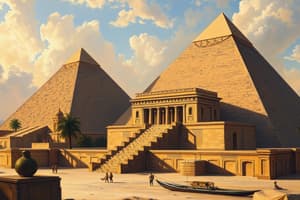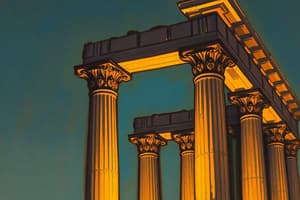Podcast
Questions and Answers
What is the Egyptian symbol for life?
What is the Egyptian symbol for life?
Akh
What does 'Ba' represent in ancient Egyptian beliefs?
What does 'Ba' represent in ancient Egyptian beliefs?
Your personality or essence
What is a cartouche?
What is a cartouche?
An oval frame used to surround the name of any important person
What does 'Ka' refer to?
What does 'Ka' refer to?
What is mummification?
What is mummification?
What is an obelisk?
What is an obelisk?
What is papyrus?
What is papyrus?
What is a pharaoh?
What is a pharaoh?
What is a sarcophagus?
What is a sarcophagus?
What was the purpose of a temple in ancient Egypt?
What was the purpose of a temple in ancient Egypt?
What was Thebes known for in ancient Egypt?
What was Thebes known for in ancient Egypt?
What does the Valley of the Kings refer to?
What does the Valley of the Kings refer to?
What are hieroglyphs?
What are hieroglyphs?
What is linen made from?
What is linen made from?
What is the role of a scribe?
What is the role of a scribe?
What is an oasis?
What is an oasis?
What is a cataract in relation to rivers?
What is a cataract in relation to rivers?
What is an alluvial fan?
What is an alluvial fan?
What is hieratic script?
What is hieratic script?
Who is Re in ancient Egyptian culture?
Who is Re in ancient Egyptian culture?
What role did Isis play in ancient Egypt?
What role did Isis play in ancient Egypt?
Who is Horus?
Who is Horus?
What is Osiris known for?
What is Osiris known for?
Who is Anubis?
Who is Anubis?
What is a dynasty?
What is a dynasty?
During what era were immense pyramid tombs built?
During what era were immense pyramid tombs built?
Who united Egypt in 3200 BC for the first time?
Who united Egypt in 3200 BC for the first time?
What was the Rosetta Stone used for?
What was the Rosetta Stone used for?
What language was part of the Rosetta Stone written in?
What language was part of the Rosetta Stone written in?
What was the job of the pharaoh?
What was the job of the pharaoh?
What was the universe called in Egyptian culture?
What was the universe called in Egyptian culture?
What natural feature prevented invasion from the south on the Nile River?
What natural feature prevented invasion from the south on the Nile River?
What were the pharaohs considered by the early ancient Egyptians?
What were the pharaohs considered by the early ancient Egyptians?
What were the pharaohs inhabited by?
What were the pharaohs inhabited by?
The figure of ___________ was often found on tombs, with her wings spread, protecting the dead.
The figure of ___________ was often found on tombs, with her wings spread, protecting the dead.
The figure of Isis was often found on tombs, with her wings spread, protecting the _________.
The figure of Isis was often found on tombs, with her wings spread, protecting the _________.
What god was responsible for judging the dead's worthiness?
What god was responsible for judging the dead's worthiness?
How did Osiris judge the dead's worthiness?
How did Osiris judge the dead's worthiness?
Why was the Nile River considered a 'gift' to the ancient Egyptians?
Why was the Nile River considered a 'gift' to the ancient Egyptians?
Flashcards
Akh
Akh
The spiritual body of light that represents life and the physical body in ancient Egyptian belief.
Ba
Ba
The individual's personality or essence that departs daily to observe the living body, returning at night for rest.
Cartouche
Cartouche
An oval frame that encircles the names of important individuals in ancient Egypt, indicating their significance.
Ka
Ka
Signup and view all the flashcards
Mummification
Mummification
Signup and view all the flashcards
Obelisk
Obelisk
Signup and view all the flashcards
Papyrus
Papyrus
Signup and view all the flashcards
Pharaoh
Pharaoh
Signup and view all the flashcards
Sarcophagus
Sarcophagus
Signup and view all the flashcards
Temple
Temple
Signup and view all the flashcards
Thebes
Thebes
Signup and view all the flashcards
Valley of the Kings
Valley of the Kings
Signup and view all the flashcards
Hieroglyph
Hieroglyph
Signup and view all the flashcards
Linen
Linen
Signup and view all the flashcards
Scribe
Scribe
Signup and view all the flashcards
Hieratic script
Hieratic script
Signup and view all the flashcards
Oasis
Oasis
Signup and view all the flashcards
Cataract
Cataract
Signup and view all the flashcards
Alluvial fan
Alluvial fan
Signup and view all the flashcards
Re
Re
Signup and view all the flashcards
Isis
Isis
Signup and view all the flashcards
Horus
Horus
Signup and view all the flashcards
Osiris
Osiris
Signup and view all the flashcards
Anubis
Anubis
Signup and view all the flashcards
Dynasty
Dynasty
Signup and view all the flashcards
Old Kingdom
Old Kingdom
Signup and view all the flashcards
King Menes
King Menes
Signup and view all the flashcards
Rosetta Stone
Rosetta Stone
Signup and view all the flashcards
Archaic Greek
Archaic Greek
Signup and view all the flashcards
Pharaoh's Role
Pharaoh's Role
Signup and view all the flashcards
Ma'at
Ma'at
Signup and view all the flashcards
Cataracts and Defense
Cataracts and Defense
Signup and view all the flashcards
Study Notes
Egyptian Concepts and Terms
- Akh: Symbol of life and the physical body represented as a being of light.
- Ba: Represents personal essence or personality, which departs daily to observe the living body.
- Cartouche: Oval frame encircling the names of significant individuals, signifying their importance.
- Ka: Unique life force or spirit, needing sustenance post-death, rejoins Ba at night for rest.
- Mummification: Preservation process of the body post-death, critical for Ka and Ba recognition; necessary for afterlife continuity.
- Obelisk: Tall, slender four-sided stone pillars carved from a single rock, often marking sacred sites.
- Papyrus: Plant used to create an early paper-like substance, integral to record-keeping and literature in ancient Egypt.
Ancient Egypt Infrastructure and Society
- Pharaoh: Ruler of ancient Egypt, seen as a god on earth.
- Sarcophagus: Stone tomb housing a wooden coffin, primarily for mummies.
- Temple: Sacred structures for religious ceremonies and worship.
- Thebes: Capital city of ancient Egypt, central to politics and culture.
- Valley of the Kings: Burial site for many pharaohs, located within desert canyons.
Writing and Language
- Hieroglyph: Picture-based writing system used for formal inscriptions, representing ideological concepts.
- Linen: Fabric derived from the flax plant, commonly utilized for clothing and wrappings.
- Scribe: Highly skilled individuals trained to read and write in complex languages, often overseeing records and documentation.
- Hieratic script: Simplified pictographic writing utilized for everyday purposes, merging symbols with sounds.
Geography and Natural Features
- Oasis: Fertile areas in deserts, essential for agricultural practices and trade routes through arid lands.
- Cataract: Elevated sections of rivers causing waterfalls or rapids, instrumental in natural defense mechanisms.
- Alluvial fan: Fertile delta formed by sedimentation from river floods, vital for agriculture.
Deities and Mythology
- Re: Chief god symbolizing the sun, regarded as the physical embodiment of the sun itself.
- Isis: Divine protector of the dead, revered for her benevolence and maternal traits.
- Horus: Protector of Egypt, recognized as the avenger of Osiris; viewed as a model son.
- Osiris: God associated with the Nile and the afterlife, depicted as a feather and judging the deceased.
- Anubis: Deity guiding souls through the afterlife, assisting the Ka in locating its body.
Dynasties and Historical Context
- Dynasty: Sequence of rulers originating from the same family lineage.
- Old Kingdom: Era marked by the construction of monumental pyramid tombs, showcasing architectural prowess.
- King Menes: Unified Egypt around 3200 BC, pivotal figure in ancient Egyptian history.
Notable Artifacts
- Rosetta Stone: Discovered in 1822, fundamental for deciphering hieroglyphics through its trilingual inscriptions.
- Archaic Greek: Language on the Rosetta Stone, enabling scholars to translate ancient Egyptian scripts.
Governance and Beliefs
- Pharaoh's Role: Maintain cosmic order and balance, ensuring harmony within the universe.
- Ma'at: Concept embodying truth, justice, and cosmic order, central to Egyptian ideology.
- Cataracts and Defense: Natural features like cataracts served as protective barriers against invasions.
Studying That Suits You
Use AI to generate personalized quizzes and flashcards to suit your learning preferences.



